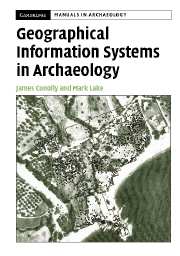Book contents
- Frontmatter
- Contents
- List of figures
- List of tables
- List of boxes
- Acknowledgements
- 1 INTRODUCTION AND THEORETICAL ISSUES IN ARCHAEOLOGICAL GIS
- 2 FIRST PRINCIPLES
- 3 PUTTING GIS TO WORK IN ARCHAEOLOGY
- 4 THE GEODATABASE
- 5 SPATIAL DATA ACQUISITION
- 6 BUILDING SURFACE MODELS
- 7 EXPLORATORY DATA ANALYSIS
- 8 SPATIAL ANALYSIS
- 9 MAP ALGEBRA, SURFACE DERIVATIVES AND SPATIAL PROCESSES
- 10 REGIONS: TERRITORIES, CATCHMENTS AND VIEWSHEDS
- 11 ROUTES: NETWORKS, COST PATHS AND HYDROLOGY
- 12 MAPS AND DIGITAL CARTOGRAPHY
- 13 MAINTAINING SPATIAL DATA
- Glossary
- References
- Index
6 - BUILDING SURFACE MODELS
Published online by Cambridge University Press: 05 June 2012
- Frontmatter
- Contents
- List of figures
- List of tables
- List of boxes
- Acknowledgements
- 1 INTRODUCTION AND THEORETICAL ISSUES IN ARCHAEOLOGICAL GIS
- 2 FIRST PRINCIPLES
- 3 PUTTING GIS TO WORK IN ARCHAEOLOGY
- 4 THE GEODATABASE
- 5 SPATIAL DATA ACQUISITION
- 6 BUILDING SURFACE MODELS
- 7 EXPLORATORY DATA ANALYSIS
- 8 SPATIAL ANALYSIS
- 9 MAP ALGEBRA, SURFACE DERIVATIVES AND SPATIAL PROCESSES
- 10 REGIONS: TERRITORIES, CATCHMENTS AND VIEWSHEDS
- 11 ROUTES: NETWORKS, COST PATHS AND HYDROLOGY
- 12 MAPS AND DIGITAL CARTOGRAPHY
- 13 MAINTAINING SPATIAL DATA
- Glossary
- References
- Index
Summary
Introduction
Surface modelling is an important analytical tool and, particularly in the case of elevation modelling, is often the final stage of GIS project development. Constructing a digital elevation model (DEM) from secondary sources such as digitised contour lines and/or spot heights, or from primary data such as LiDAR or DGPS survey, is a frequent objective of surface modelling (Atkinson 2002). Surface models can also be derived from a wide range of point-based environmental and anthropomorphic data, such as artefact counts or soil chemistry (e.g. Robinson and Zubrow 1999; Lloyd and Atkinson 2004). The derivation of a continuous surface from a set of discrete observations involves a process called interpolation and the selection of an appropriate interpolation technique depends on the structure of the sample data plus the desired outcome and characteristics of the surface model. This chapter begins by reviewing some of the more common interpolation methods and is followed by a more detailed review of techniques for building DEMs from contour data.
Interpolation
Interpolation is a mathematical technique of ‘filling in the gaps’ between observations. More precisely, interpolation can be defined as predicting data using surrounding observations. It can be contrasted to extrapolation, which is the process of predicting values beyond the limits of a distribution of known points. To use a simple example, if n and m are unknown values within the set of numbers {2, 4, n, 8, 10, m}, then using a simple model of linear change n could be interpolated as being equal to 6.
- Type
- Chapter
- Information
- Geographical Information Systems in Archaeology , pp. 90 - 111Publisher: Cambridge University PressPrint publication year: 2006

